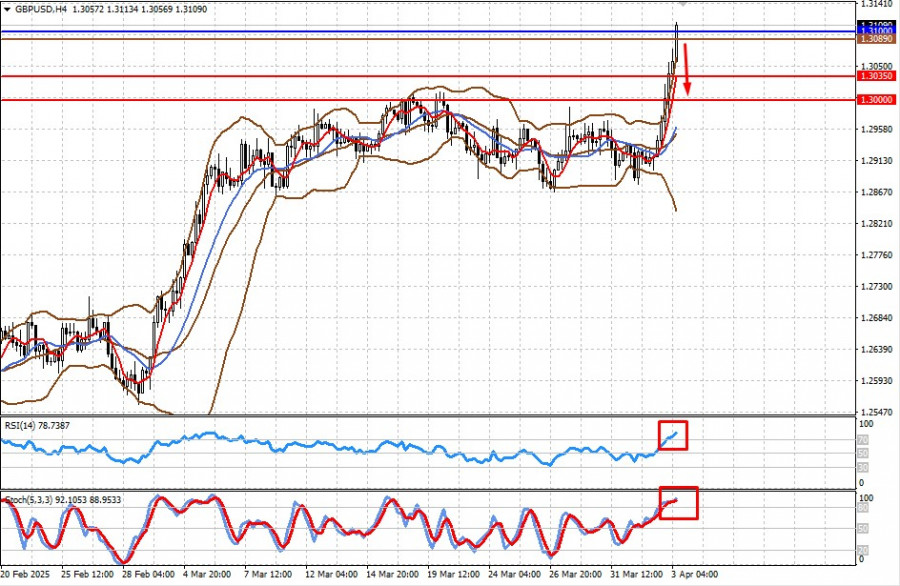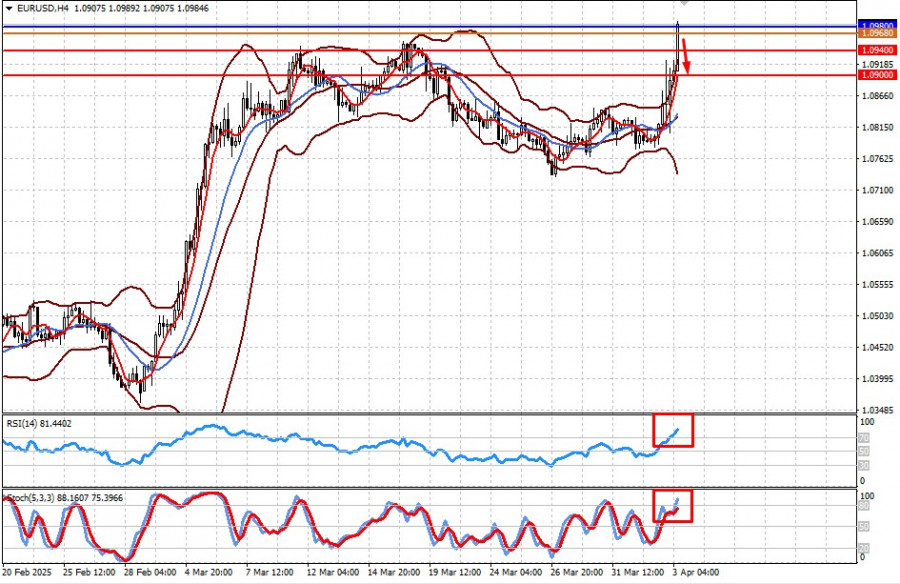Lihat juga


 03.04.2025 09:12 AM
03.04.2025 09:12 AMThe U.S. dollar had recently managed to stay above the key 104.00 mark on the ICE index, giving hope that a further decline might be avoided. But why did it tumble against other major currencies, especially considering that trade tariffs should also negatively impact the countries targeted by them?
Yes, this might seem odd at first glance, but there are clear reasons behind it, and they are likely to continue weighing on the dollar until the situation stabilizes.
As stated in a previous article, had Trump not introduced anything beyond the initially announced tariffs, the dollar might have received noticeable support yesterday. But that didn't happen. Instead, the U.S. president went beyond previously priced-in measures on the Forex market, equity indices, and Treasury yields. In addition to a base tariff of 10%—a more moderate figure than the previously floated 20%, which would have been seen as a positive—he announced additional tariffs for certain countries. According to Evercore ISI, the new weighted average tariff rate may rise to 29% after all new tariffs are implemented, the highest in over a century. This means that, collectively, the U.S. is imposing significantly higher trade barriers than initially expected.
Fears of a full-blown economic crisis and recession in the U.S. have driven investors into Treasuries, causing yields to plunge and adding downward pressure on the dollar. This decline in the Forex market is not due to strength in other currencies but rather the dollar's weakness. For example, the euro's rise contradicts the eurozone's economic issues. According to recent data, declining inflation raises the likelihood of further interest rate cuts—clearly a bearish factor for the euro versus the dollar, which might eventually find support on expectations of rate hikes if inflation picks up later this year.
In short, the dollar's drop is mostly an emotional reaction. This decline may be short-lived, ending once there's more clarity on the actual U.S. tariff rates and the retaliatory measures from trade partners. As mentioned above, fear of the unknown is pushing the dollar down. However, this decline could benefit the U.S., as it improves the competitiveness of American exports, which could strengthen the economy in the long run. In the meantime, speculators will likely take full advantage of the "tariff reality" before entering the market again at lower, more favorable price levels.
The pair is trading above the 1.3100 level. If it fails to hold above this mark, a pullback toward 1.3035 and then 1.3000 is likely.
The pair is trading above the 1.0880 level. If it fails to stay above this level, a downward correction toward 1.0940 and then 1.0900 is possible.
You have already liked this post today
*Analisis pasar yang diposting disini dimaksudkan untuk meningkatkan pengetahuan Anda namun tidak untuk memberi instruksi trading.
Pada hari Kamis, para investor menyadari bahwa saat ini tidak ada yang namanya stabilitas. Volatilitas pasar yang tinggi tetap ada dan akan terus mendominasi untuk beberapa waktu. Penyebab yang sedang
Sejumlah besar peristiwa makroekonomi dijadwalkan pada hari Jumat, tetapi tidak ada yang diperkirakan akan memengaruhi pasar. Tentu saja, kita mungkin melihat reaksi jangka pendek terhadap laporan individu, tetapi secara umum
Pada hari Kamis, pasangan mata uang GBP/USD juga diperdagangkan lebih tinggi. Sebagai pengingat, faktor makroekonomi dan fundamental tradisional saat ini memiliki sedikit atau tidak ada pengaruh pada pergerakan mata uang
Pada Rabu malam, pasangan mata uang EUR/USD mengalami penurunan tajam, tetapi menunjukkan sedikit pemulihan sepanjang hari. Pada hari Kamis, pertumbuhan berlanjut—serangkaian fluktuasi ini hanya bisa digambarkan sebagai roller coaster. Pergerakan
Pada hari Kamis, pasangan mata uang GBP/USD juga menunjukkan pertumbuhan yang kuat, meskipun tidak sekuat pasangan EUR/USD. Pound hanya naik sekitar 200 pip—yang bukan merupakan pergerakan signifikan dalam kondisi saat
Laporan CPI yang dirilis pada hari Kamis menunjukkan inflasi yang lebih lemah daripada ekspektasi. Pasar merespons dengan sesuai: dolar AS kembali mengalami tekanan (Indeks Dolar AS jatuh ke kisaran 100,00)
Kenaikan indeks saham Eropa, perlambatan inflasi AS, dan fakta bahwa tarif rata-rata AS tidak berubah secara signifikan meskipun ada penundaan 90 hari, semuanya berkontribusi pada kenaikan EUR/USD. Pasangan mata uang
Your IP address shows that you are currently located in the USA. If you are a resident of the United States, you are prohibited from using the services of InstaFintech Group including online trading, online transfers, deposit/withdrawal of funds, etc.
If you think you are seeing this message by mistake and your location is not the US, kindly proceed to the website. Otherwise, you must leave the website in order to comply with government restrictions.
Why does your IP address show your location as the USA?
Please confirm whether you are a US resident or not by clicking the relevant button below. If you choose the wrong option, being a US resident, you will not be able to open an account with InstaTrade anyway.
We are sorry for any inconvenience caused by this message.


